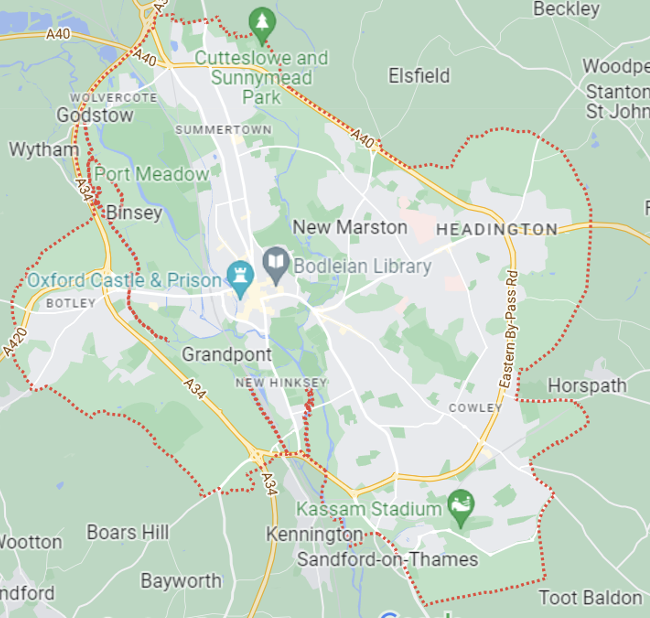Location Overview – Oxford is the only city in Oxfordshire. It lies 56 miles northwest of London, 64 miles southeast of Birmingham and 61 miles northeast of Bristol. The city is home to Oxford University, the oldest university in the UK. Oxford offers buildings in every style of English architecture since late Anglo-Saxon times. Oxford’s economy includes manufacturing, publishing, science-based industries, education, research, and tourism. It has numerous major tourist attractions, many from the university and colleges. Oxford is also famous for several institutions, such as the Carfax Tower and the University Church of St Mary the Virgin, which offer magnificent views over the city’s spires. Advanced Driver training throughout Oxford is becoming popular for private and business drivers, such as delivery and taxi drivers.
Oxford has seen significant efforts over the years to improve road safety, especially with the increasing popularity of cycling and pedestrian travel. There is a particular focus on balancing the needs of both motor vehicles and non-motorised road users in a city that combines ancient infrastructure with modern demands.
If you’re looking for more specific information about Oxford’s road safety initiatives or the latest updates, checking the official Oxford City Council website or local news outlets can provide the most up-to-date resources. We have outlined more about road safety in Oxford at the end of this page.

During a session, we typically look at the following:
* Understanding observational elements of motoring(seeing) and building these into your driving plan
* How to become a more skilful driver
* Manoeuvres and driving in restricted areas
* Undoing years of ingrained bad habits
* The system of car control – IPSGA
* Driving in busy urban environments
* Car control (looking at gears, steering, and use of signals etc.)
* Learning how to anticipate the actions of other road users better
* Learning how you and other drivers think when behind the wheel
* Coping with bad weather
* Understanding your own limitations and at-risk factors
* Developing an improved attitude towards motoring
* Coping and defusing with road rage
* Learning why skids can happen and how to control them
* Learning to see and not just look when driving
Once the training is complete, a PDF report will be sent to you with several things assessed, such as confidence, forward planning, attitude, vehicle control, etc. This report is beneficial as it’s completely bespoke to the driver and provides valuable tips and insights for future safer driving. Each report is thoroughly verified and documented – proof you’ve had driver training with a DVSA-registered professional.
Key learning points of our driver training:
* Demonstrate your intention to become a safer, improved driver
* Deal with and address issues which may have been holding you back
* Work on any issues which could be impacting your level of skill and safety
* Become a much improved, more skilful motorist
Training is a little different for commercial clients – the end client, who has the on-road training, is often not the person who decides to do the training.
While we help the driver to improve, from a commercial perspective, your business will benefit from the following:
* Demonstrating your businesses Duty of Care
* Lower fuel costs
* Providing the opportunity for an employee to develop
* Showing you care
* Potentially lower your fleet insurance costs

Oxford’s central location has several linking transport routes – which we use for a number of our driving courses in the city. The Oxford Ring Road or A4142 (southern part) circles the city centre and the close suburbs of Marston, Iffley, Cowley and Headington. It comprises the A34 to the west, a tiny section of the A44, the A40 to the north and northeast, and A4142/A423 to the east. Since 2011 we have been helping drivers become the safest drivers across Oxford and the surrounding towns. Our courses are very different from other providers, we will come to you, and you can use your own car and not have to attend a centre. Our tutors are all highly qualified and registered with the DVSA and will provide a detailed report after training.
Regardless if you are a private client or a business customer, we can create a course based on your requirements anywhere across the UK.
Our Advanced Driver courses do vary in structure, although we have many courses based on day durations:
3.5hour session
7hour session (which can be split for two drivers if needed)
2 x 3.5hour sessions
3 x 3.5hour sessions
The 7-hour session can be split between two drivers, which is both time and cost-efficient. One driver in the morning, usually 9.00 to 12:30, and the second in the afternoon, usually 13:00 to 16:30. We can be flexible with start times and can start earlier than 9 am if needed. Each driver has 3.5hr on-road training.
Longer Duration Courses:
Our bespoke 3, 4 and 5 x 3.5hr sessions are mostly suited to those with specific driving anxieties and issues. These can include driving anxiety, motorway confidence, fear of driving in new areas, post-RTC or for those that have not driven in many years.
The longer courses are booked mainly by private drivers, although they are also open to our business clients. Those who commit to the longer-duration courses see change happen over the sessions as they regain confidence and conquer the specific issues they face.
Talk with us:
While we cover as many things as possible on this page, we understand you may still have questions. If you wish to discuss anything, please call, or email us. A member of our team will only be too pleased to help you. We can help both private individuals and business clients.
If you’re looking at a quote for many drivers, we will be able to provide such, along with how we can best approach the training based on your business needs. Training large numbers requires a little extra planning. Still, we have many years of experience managing extensive, often complex driver training sessions involving multiple start locations and hectic diaries.
Road Safety Risks and Information – Oxford
Oxford is a vibrant city set between the Areas of Natural Beauty, the Cotswolds, and the Chiltern Hills. It is west of the M40, and several busy A-road routes serve the city.
The A40 skirts the north of Oxford City and links London to Cheltenham; this is an extremely busy route with numerous collision sites, especially at the challenging London Road junction at Headington. This intersection links the London Road A420 that travels into Oxford via the Headington Road and St. Clements Street, the Bayswater Road and the M40, continuing around the northern edge of Oxford. This intersection has a traffic light system that should help to calm traffic, but there are still numerous accidents noted in the past few years; these can be due to excess speed when joining the roundabout from the fast A40 or poor lane positioning for exiting, but with all collisions reduced observations will account for most. At the Woodstock Road Roundabout, the A40 meets the A4144 Woodstock Road and the NCR5, which travels into the City Centre, and the Godstow Road, which runs through to Wytham. This is another very hazardous intersection with numerous accidents. The Banbury Road roundabout has very similar collision statistics. These roads lead into Oxford City centre and have very high collision rates along the entire route. They travel through very high residential areas, and the routes are shared with public transport, cyclists and pedestrians. The collisions are very severe at times, even though the speeds are quite low compared to motorway driving. At nearly every road crossing, there are accident sites; these are due to a lack of observations and indications; some of the worst affected areas are Banbury Road between Lonsdale Road and Diamond Place and the fork in the road where they both meet St Giles Street.
The A34 runs down Oxford’s western side, and the Botley Interchange joins the A420 to the B4044 West Way. On this slight stretch of road, the entrance and exits to the Seacourt Retail Centre are areas to be aware of as several accidents are seen along this area. This is a jam-packed section of road as it carries a lot of traffic from the busy A34 into Oxford. West Way merges into Botley Road, and this is a hazardous route, especially during rush hours. Botley Road is a residential area with many drives opening onto the busy road and small commercial and retail areas with vehicles moving on and off the route. There are many hazards to look out for in areas such as these, including cyclists and pedestrians, so you must use all the tools available: mirrors, indicators, and, most of all, a good set of observation and anticipation skills.
Oxford City Centre, one of the oldest cities in the UK, is a maze of narrow streets, some of which are now pedestrianised. However, the surrounding streets, like George Street and High Street, are riddled with collision sites. These accidents often involve cyclists and pedestrians. Inner-city driving can be extremely hazardous, leading to congestion, traffic diversion, and further accidents. It’s crucial to be acutely aware of your surroundings in busy urban areas to avoid unnecessary collisions.
If you’re a frequent traveler on specific roads in the Oxford area and would like to know which parts are at a higher risk of collisions, we’re here to help. We provide a free service to anyone interested in understanding the road safety risks in their area. Don’t hesitate to reach out to us.
